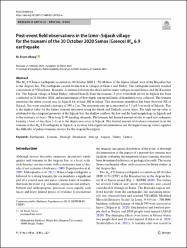Post-event field observations in the İzmir–Sığacık village for the tsunami of the 30 October 2020 Samos (Greece) M w 6.9 earthquake
Citation
Aksoy, M. E. 2021. "Post-Event Field Observations in the İzmir–Sığacık Village for the Tsunami of the 30 October 2020 Samos (Greece) M w 6.9 Earthquake." Acta Geophysica. doi:10.1007/s11600-021-00582-w.Abstract
The Mw 6.9 Samos earthquake occurred on 30 October 2020 11:51 offshore of the Samos island, west of the Kuşadası bay in the Aegean Sea. The earthquake caused destruction in villages of Greece and Turkey. The earthquake intensity reached a maximum of VII in İzmir–Bayraklı. A tsunami followed the shock and hit many villages around Samos and the Kuşadası bay. The Sığacık village of Izmir-Turkey suffered heavily from the tsunami. A post-event field survey in Sığacık has been conducted on 31 October 2020, and measurements of flow depth, run-up and limits of inundation were collected. The tsunami inundated the entire coastal area in Sığacık for at least 200 m inland. The maximum inundation has been observed NE of Sığacık. Sea water reached a distance of 391 ± 2 m. The maximum run-up is measured as 5.3 ± 0.3 m north of Sığacık. This is the highest value for the Samos tsunami measured along the Greek and Turkish coastal areas. The high run-up value is attributed to the elongated geometry of the Sığacık bay, the shallow seafloor, the low and flat land morphology in Sığacık and to the existence of four > 70-m-long E–W trending channels. The tsunami left limited amount of clay to sand size sediments forming a layer of less than 2–3 cm in the depression areas in Sığacık. The limited amount of evidence remained from the tsunami of this Mw 6.9 earthquake in Sığacık (a location with significant inundation and the highest run-up value) signifies the difficulty of palaeo-tsunami surveys for the Aegean Sea region.


















